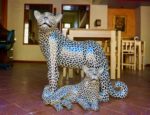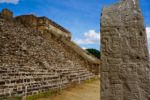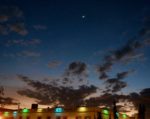 Oaxaca, 1/20/2018 – The business card that Fernando Limon had handed me in 1994 had an address: Santos Degollado #606.
Oaxaca, 1/20/2018 – The business card that Fernando Limon had handed me in 1994 had an address: Santos Degollado #606.
The street was well away from the Centro, a sun-drenched avenue of breached and pastel houses. There were no cute cafés, no artisan mescal shops, no souvenir vendors. My taxi pulled up by the curb, in front of #602. I stepped out and walked down the street.
Number 606 seemed shuttered, but a loose blue curtain was blowing through the open, iron-gated doorway of #604. Two men and an elderly woman were inside, talking quietly in the cool darkness that defines local living rooms. I got their attention, and asked them: Does Fernando Limon live next door?

View of the ruins at Monte Alban, Oaxaca
Their eyes went wide with surprise, and they began talking quickly. Two of them, brothers – Javier and Luis Dominguez – stepped out onto the hot sidewalk. They had a great deal to say, and I understood only snippets: The home no longer belonged to the Limon family. Fernando and his wife Charlene were no more — whatever that meant. Their daughter Luisa? They believed she might still live in Oaxaca, but …
Having reached the limit of my primitive Spanish, I called Sarai: my sharp liaison with the Oaxaca Tourism Board. She’d know what to do. Once I’d explained the situation, I handed the telephone over to Javier. They spoke for a very long time before he handed it back to me.
“Jeff? It’s true,” Sarai said sadly. “What he told you. Fernando and Charlene both have died. But they believe Rosita is alive.”
“Rosita?”
“Yes, that’s their daughter. She was named after the grandmother, Rosa.”
“But I knew her as Luisa.”
“They say her name is Rosita.”
Had I had it so wrong all these years? It didn’t seem possible. But before I could question Sarai further, Luis Dominguez motioned for the phone. The younger brother had been doing some sleuthing while we spoke, and he had some news: He had located the telephone number of Fernando’s sister.
Sarai recited the number back to me, making sure I wrote it down correctly. She asked if I wanted her to call, and explain who I was in Spanish. For some reason, it didn’t seem like the right moment. I wanted to be with Sarai when she phoned Fernando’s sister; if she spoke English, I could speak with her directly.
“Can you meet me this evening?” I asked Sarai. She replied that she could. We’d rendezvous at 5 p.m., at a popular coffee shop near the Church of Santo Domingo, Café Brujula, and make the call together.

Ancient messages that may or may not be decipherable
All of this was staggering news. Unsure what to do with myself, I hired a car and left Oaxaca city, climbing steeply to the site of the ancient Zapotec ruins of Monte Alban. I’d last visited the vast, majestic site in January of 1994, with Fernando, Charlene and Luisa. We had talked about impermanence; how even the greatest civilizations, let alone their members, vanish in time. Walking morosely through the enormous plazas, plinths, steles, and stairways, I wondered how my long lost friends had died. Both were year younger than I. Disease? An accident? But Fernando had apparently died first, and Charlene just a few years later. A terrible tragedy for Luisa, or Rosita, or whatever her actual name might be. And I felt stricken, too.

View above the Café Brujula
But generations continue, and I had learned one more thing from the Dominguez brothers: Rosita/Luisa had a son. His name was Freddy. And with any luck, I would l learn much more in the evening.
